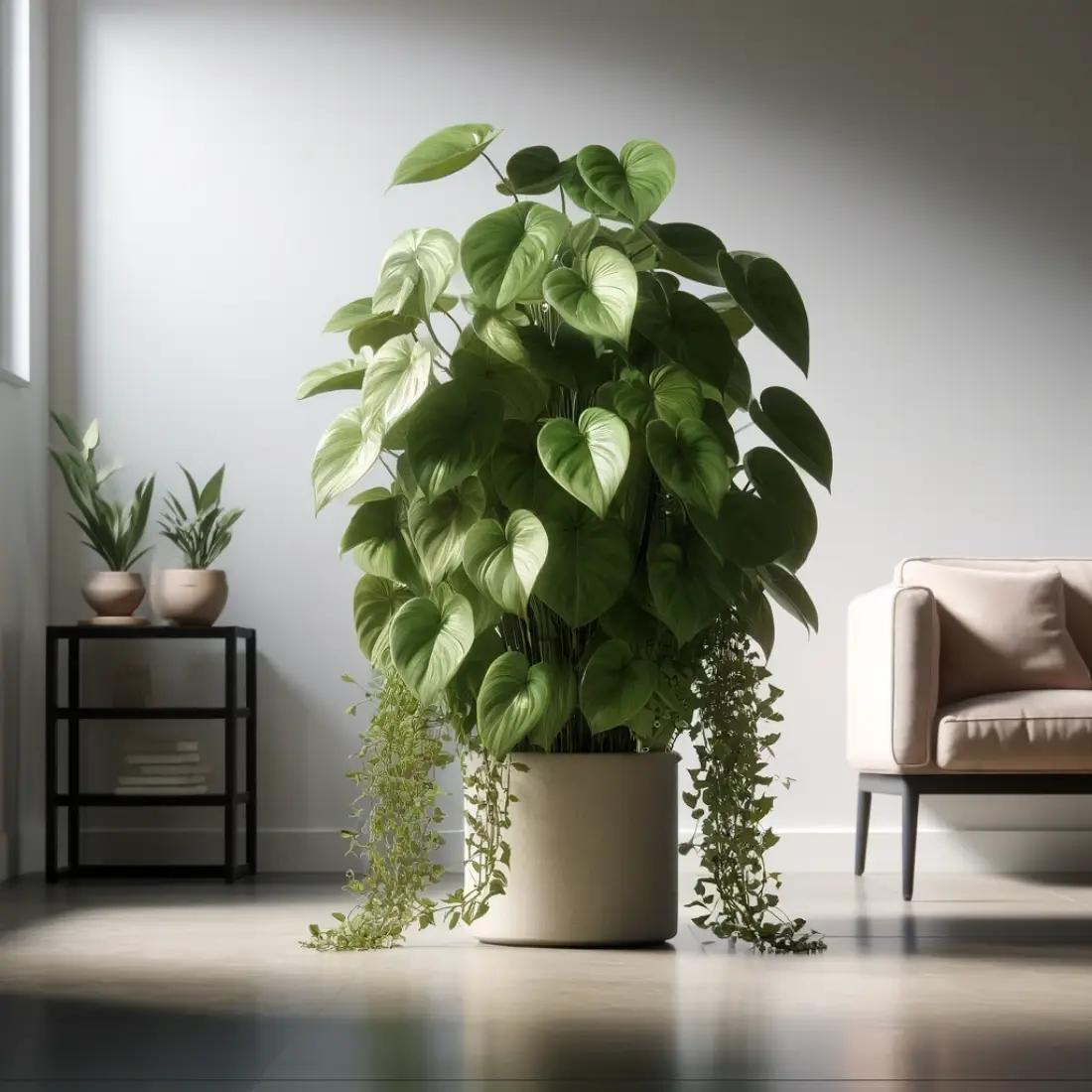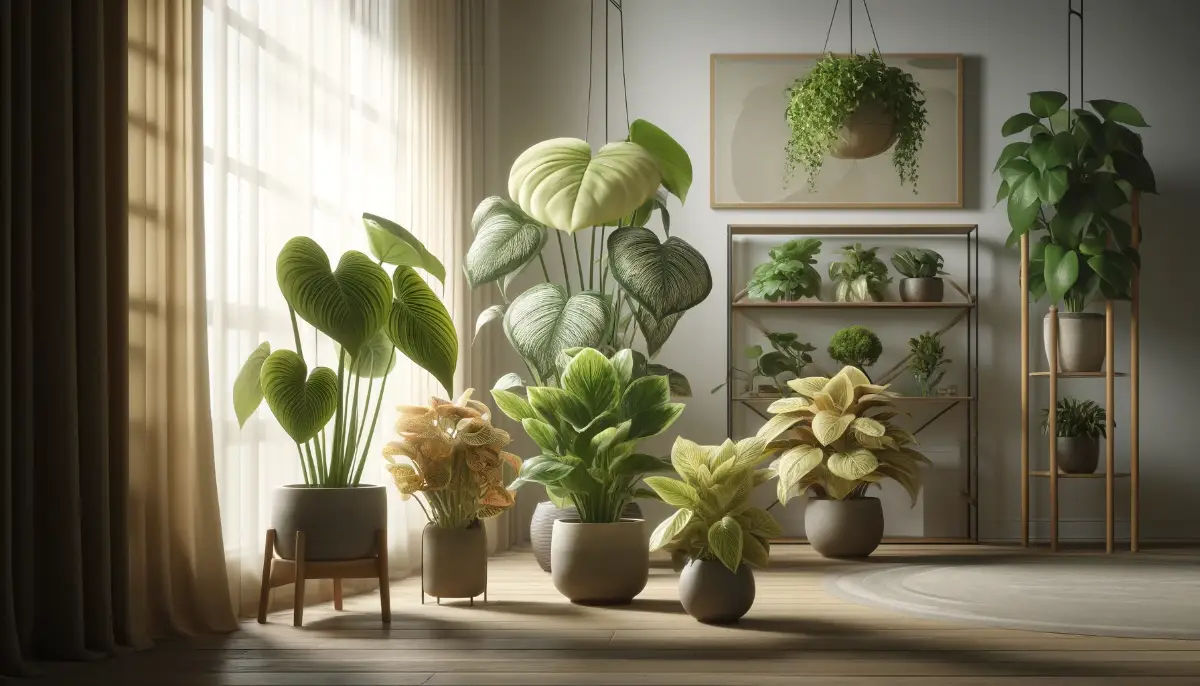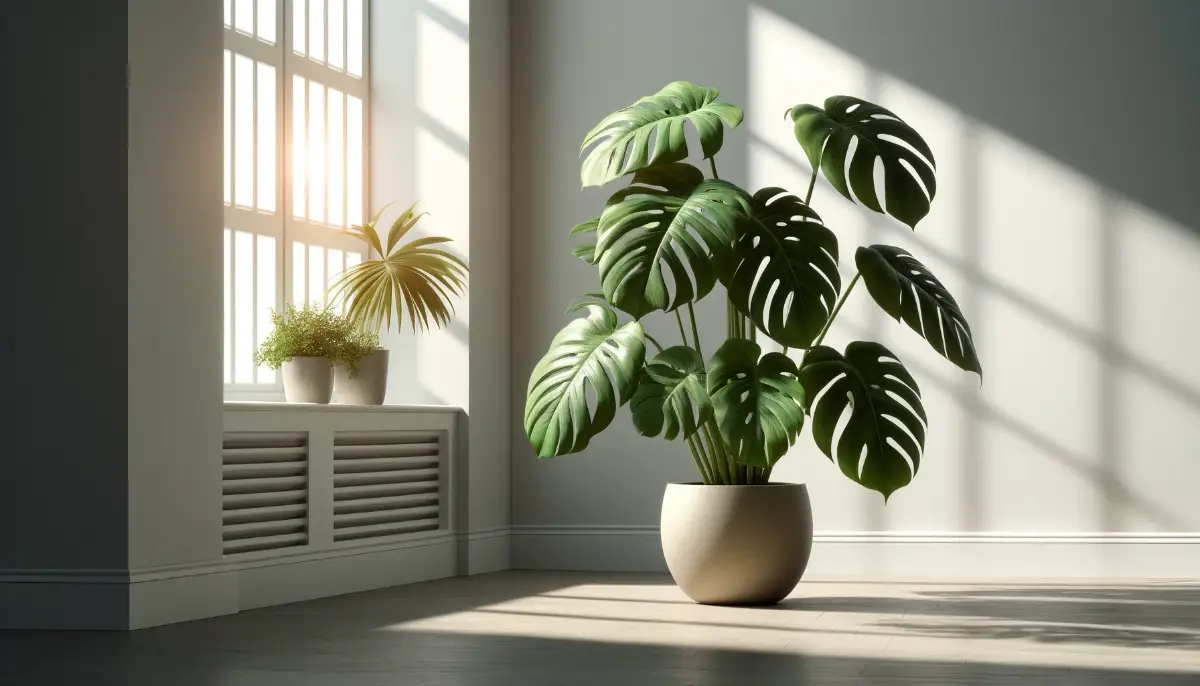Philodendron Hederaceum, commonly known as the Heartleaf Philodendron, is a popular houseplant cherished for its lush, heart-shaped leaves and easy-going nature.
Originating from the tropical regions of Central America and the Caribbean, this plant has adapted remarkably well to indoor environments, making it a favorite among both novice and seasoned plant enthusiasts.
The Heartleaf Philodendron is not only visually appealing but also plays a significant role in improving indoor air quality. According to research, it is effective in removing indoor pollutants such as formaldehyde, making it an excellent choice for homes and offices.
The plant’s trailing vines can create a vibrant green cascade, adding a touch of nature’s serenity to any room. Its adaptability to a variety of indoor conditions and minimal care requirements further enhance its popularity.
[zynith-toc]
Optimal Growing Conditions for Philodendron Hederaceum
To thrive indoors, Philodendron hederaceum requires specific conditions that mimic its natural tropical habitat. Here’s a detailed breakdown of the optimal growing conditions for this plant:
Light Requirements
- Ideal Light Conditions: Heartleaf Philodendron performs best in bright, indirect light. It can tolerate low light conditions, but its growth may slow, and the leaves may become less vibrant. Direct sunlight should be avoided as it can scorch the leaves.
- Effects of Light Variance: In too little light, the plant’s stems may become leggy and the leaves sparse. Conversely, excessive direct light can lead to burnt leaves. East or north-facing windows are ideal locations.
Watering Needs
- Proper Watering Technique: Water the plant when the top inch of soil feels dry to the touch. It’s important to ensure the pot has good drainage to prevent waterlogging, which can lead to root rot.
- Signs of Overwatering and Underwatering: Yellowing leaves often indicate overwatering, while droopy leaves can suggest the plant is underwatered.
Temperature and Humidity
- Ideal Temperature Range: The ideal temperature for Heartleaf Philodendron is between 65°F and 80°F (18°C to 27°C). It should be protected from drafts and drastic temperature changes.
- Necessary Humidity Levels: This plant prefers high humidity but can adapt to average household humidity. For optimal growth, maintaining a humidity level around 60% is ideal. Misting the leaves or using a humidity tray can help achieve this environment.
Soil and Fertilization
- Suitable Soil Mix: A well-draining, peat-based potting soil is best. The soil should retain moisture but allow excess water to drain quickly to avoid soggy conditions.
- Fertilizer Types and Application Schedule: Feed the plant with a balanced, water-soluble fertilizer every 4 to 6 weeks during the growing season (spring and summer). Reduce feeding in the fall and winter when the plant’s growth naturally slows.
Planting and Repotting Heartleaf Philodendron
Proper planting and timely repotting are crucial for the health and growth of your Heartleaf Philodendron. Here’s a guide to ensure that you provide the best conditions for your plant:
When to Pot and Repot
- Initial Potting: When you first bring your Philodendron home, ensure it is in a suitable pot with good drainage. If not, repot it into an appropriate container.
- Repotting Frequency: Heartleaf Philodendrons typically need to be repotted every 18-24 months or when the roots start to grow out of the drainage holes or circle the inside of the pot.
- Best Time to Repot: Early spring is the ideal time for repotting, as the plant is entering its growth phase and can recover more quickly from any stress caused by repotting.
Choosing the Right Pot
- Size: Choose a pot that is 1-2 inches larger in diameter than the current one. Avoid pots that are too large, as excess soil can hold water and lead to root rot.
- Material: Pots made from breathable materials like terracotta are ideal as they allow soil to dry more evenly and help prevent overwatering. However, plastic pots are also acceptable and can retain moisture better in drier environments.
Repotting Steps
Preparation: Water the plant a day before repotting to ensure the soil is moist and roots are more pliable.
Removing the Plant: Gently remove the plant from its current pot, being careful not to damage the roots. Shake off excess soil and inspect the root system for any signs of decay or disease, trimming as necessary.
New Pot Preparation: Cover the drainage hole of the new pot with a piece of screen or coffee filter to prevent soil from escaping. Fill the bottom of the pot with a fresh, well-draining potting mix.
Positioning the Plant: Place the plant in the new pot and gently spread the roots. Fill in around the roots with additional potting soil, pressing down lightly to eliminate air pockets.
Final Touches: Water the plant thoroughly after repotting to help settle the soil around the roots. Keep the plant in a shaded area for a few days to allow it to recover from the repotting stress.
Aftercare
- Watering After Repotting: After the initial watering, allow the top inch of soil to dry out before watering again. This helps prevent root rot and encourages the roots to grow into the new soil.
- Observation: Monitor your plant closely for the first few weeks after repotting for signs of stress, such as drooping or yellowing leaves, and adjust care as necessary.
Maintenance and Pruning of Philodendron Hederaceum (Heartleaf Philodendron)
Proper maintenance and regular pruning are essential for keeping your Heartleaf Philodendron looking its best:
Regular Maintenance
- Watering: Consistency is key in watering. Ensure the top inch of soil dries out before watering again. Overwatering can lead to root rot, while underwatering can stress the plant.
- Cleaning the Leaves: Dust can accumulate on the leaves, reducing the plant’s ability to photosynthesize efficiently. Gently wipe the leaves with a damp cloth or sponge to keep them clean and healthy.
- Rotating the Plant: To ensure even growth on all sides, rotate your plant periodically. This prevents the plant from leaning towards the light source.
Pruning Techniques
- When to Prune: The best time to prune is during the spring or early summer, which corresponds with the plant’s active growth phase.
- How to Prune: Use clean, sharp scissors or pruning shears. Cut back any excessively long vines to encourage bushier growth. This will stimulate new growth from the cut points and the base of the plant.
- Deadheading and Removing Yellow Leaves: Regularly remove any dead or yellowing leaves by clipping them at the base of the stem. This helps redirect the plant’s energy towards healthier growth.
Promoting Fuller Growth
- Pinching: Pinch back the growing tips of the vine just above a leaf node (where the leaf and stem meet). This encourages lateral growth, making your plant fuller.
- Repositioning: Ensure the plant is in an optimal location where it gets adequate light. Insufficient light can cause the plant to become leggy and sparse.
Propagation Methods for Philodendron Hederaceum
Propagating Philodendron hederaceum is a straightforward and satisfying process that can help you multiply your plant collection or share it with friends and family. Here are detailed steps for two common methods of propagation: stem cuttings in water and in soil.
Propagation by Stem Cuttings in Water
Select a Cutting:
- Choose a healthy vine that has at least 2-3 nodes (points where leaves attach to the stem). The cutting should be about 4-6 inches long.
Prepare the Cutting:
- Use clean, sharp scissors or pruning shears to make a cut just below a node. Remove the lower leaves so that at least two nodes are bare.
Rooting in Water:
- Place the cutting in a glass or jar of water, ensuring that at least one node (preferably two) is submerged. The remaining leaves should be above the water line to prevent rot.
- Change the water every few days to keep it fresh and reduce the risk of bacterial growth.
Transplanting:
- Once the roots are about an inch long, which typically takes a few weeks, the cutting can be transplanted into soil. Use a well-draining potting mix suitable for philodendrons.
Propagation by Stem Cuttings in Soil
Select and Prepare a Cutting:
- Follow the same guidelines as for water propagation to select and prepare your cutting.
Rooting Directly in Soil:
- Dip the cut end of the stem in rooting hormone powder to enhance root growth. This step is optional but can help stimulate rooting.
- Plant the cutting in a pot filled with moist, well-draining potting soil. Bury at least two nodes beneath the soil surface.
- Use a clear plastic bag or a propagation dome to cover the pot, creating a humid environment that mimics a greenhouse.
Care During Root Development:
- Keep the soil consistently moist but not waterlogged. Remove the plastic cover periodically to allow fresh air in and prevent mold growth.
- Place the pot in bright, indirect light.
Transplanting:
- After roots develop, which can be checked by gently tugging on the cutting to feel resistance, gradually acclimate the plant to less humid conditions by removing the cover for longer periods each day.
Tips for Successful Propagation
- Timing: Spring and summer are the best times for propagation, as the warmer temperatures and longer daylight hours support quicker root development.
- Patience: Root development can vary widely depending on environmental conditions and the health of the cutting. Be patient and give your cuttings time to establish.
- Aftercare: Once your new plants are established, follow regular care guidelines for watering, light, and fertilization to promote healthy growth.
Common Pests and Diseases of Philodendron Hederaceum (Heartleaf Philodendron)
Philodendrons, like many houseplants, can be susceptible to a variety of pests and diseases. Effective identification and treatment are essential to keep your plant healthy.
Common Pests:
- Spider Mites: Tiny spider-like pests that cause yellow or brown spots on leaves and fine webs on the plant.
- Mealybugs: Small, white, cottony pests that cluster in leaf axils, on the undersides of leaves, and along stems.
- Aphids: Small, soft-bodied insects that might be green, yellow, or black, typically found on new growth or the undersides of leaves.
Helpful Articles:
How to Spot, Treat, and Prevent Scale Insects Naturally
Natural Methods to Control Mealybug Infestations
Effective Methods to Deal with Aphids
Treatment:
Isolation: First, isolate the affected plant to prevent the spread to other houseplants.
Manual Removal: Wipe off mealybugs and aphids with a cotton swab dipped in rubbing alcohol.
Insecticidal Soap: Treat the plant with insecticidal soap or neem oil, focusing on areas where pests are visible. Apply 2-3 times at weekly intervals to catch newly hatched pests.
Environmental Control: Increase humidity around the plant as spider mites thrive in dry conditions.
Common Diseases:
- Root Rot: Often caused by overwatering, leading to blackened, mushy roots.
- Leaf Spot Disease: Caused by bacteria or fungi, presenting as brown or black spots on leaves.
Prevention:
Proper Watering: Ensure the plant is not overwatered by letting the top inch of soil dry out between waterings.
Good Air Circulation: Maintain good air circulation around your plants to help keep the foliage dry and reduce the risk of fungal infections.
Cleanliness: Regularly clean fallen debris and dead leaves from the plant and its surface to prevent the growth of mold and fungi.
Troubleshooting Common Issues
Common Issues
- Drooping Leaves: Often a sign of either underwatering or overwatering. Check the soil moisture level to determine the cause.
- Leaf Discoloration: Yellow leaves may indicate overwatering, poor drainage, or a nutrient deficiency. Brown tips or edges often suggest under-watering or low humidity.
Diagnosing and Addressing Problems
Soil Check: Start by checking the soil moisture. If the soil is soggy, improve drainage and adjust watering practices.
Light Exposure: Ensure the plant is not receiving too much direct sunlight or too little light. Adjust the plant’s location as necessary.
Fertilization: Yellowing may also be due to nutrient deficiencies, particularly if the plant has not been fertilized regularly. Apply a balanced, water-soluble fertilizer according to package instructions.
Pest Examination: Regularly inspect your plant for signs of pests, as they can contribute to poor plant health and discoloration.
Environmental Factors: Consider if there have been any recent changes in the plant’s environment, such as temperature fluctuations or changes in humidity, and adjust care accordingly.
FAQs about Caring for Philodendron Hederaceum (Heartleaf Philodendron)
What is the best light for a Heartleaf Philodendron?
Heartleaf Philodendron thrives in bright, indirect sunlight. It can tolerate low light but will grow more vigorously and maintain vibrant leaf color in optimal lighting conditions.
How often should I water my Heartleaf Philodendron?
Water when the top inch of soil feels dry. Typically, this will be about once a week, but frequency should be adjusted based on humidity, light levels, and temperature.
Does Heartleaf Philodendron need humidity?
While it can adapt to average indoor humidity, this plant prefers a more humid environment. Increasing humidity with a humidifier or pebble tray can promote healthier growth and prevent leaf tips from browning.
When should I repot my Heartleaf Philodendron?
Repot every 18-24 months, or when you notice the roots are becoming crowded in the pot. Spring is the best time to repot as the plant is entering its growth phase.
What type of fertilizer should I use for a Heartleaf Philodendron?
Use a balanced, water-soluble fertilizer diluted to half the recommended strength every 4-6 weeks during the growing season (spring and summer).
How do I propagate a Heartleaf Philodendron?
The easiest method is via stem cuttings. Cut a 4-6 inch piece of stem with at least 2 nodes, and root in water or directly in soil.
How do I treat yellow leaves on my Heartleaf Philodendron?
Yellow leaves can be a sign of overwatering or underfeeding. Check the moisture level of the soil and adjust watering habits or apply a balanced fertilizer if necessary.
What are common pests that affect Heartleaf Philodendron, and how do I treat them?
Common pests include spider mites, mealybugs, and aphids. Treat infestations with insecticidal soap or neem oil, ensuring to cover all leaf surfaces.
My Heartleaf Philodendron is drooping despite regular watering. What could be wrong?
Drooping can be a sign of both overwatering and underwatering. Check if the soil is too wet or dry. Also, ensure the pot has adequate drainage.
Can Heartleaf Philodendron be grown outdoors?
In temperate climates, Heartleaf Philodendron can be grown outdoors in a shaded area during warm months. However, it must be brought indoors before temperatures drop below 50°F (10°C) to avoid cold damage.









